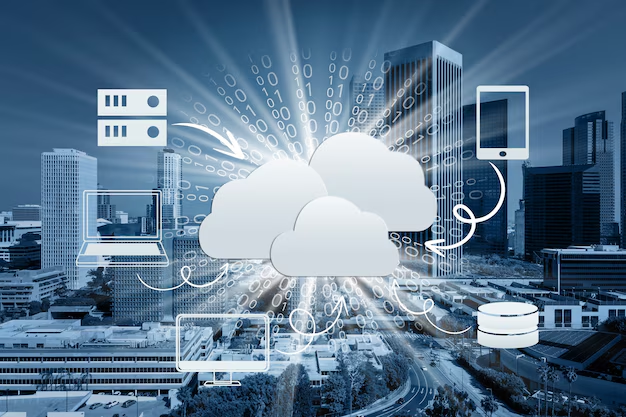Today in the digital age, and more so, one of the most dynamic technological changes is cloud computing in today’s time. In America, cloud computing is fast becoming a pillar for future technology and economic advancement. It has changed industries, opened opportunities to businesses, and now even makes government operations much better by providing access to storage, analysis, and data across several remote servers. This study seeks to find out how cloud computing is preparing a bright digital future in the USA.
Understanding Cloud Computing
Cloud computing is delivering computing services-from server storage to database networking and software-over the Internet (“cloud”). Cloud computing provides organizations access to resources on demand, rather than through an organization’s all-important physical hardware and its local servers. It caters to the needs of business, educational, and governmental organizations.
Benefits of Cloud Computing to America

Cloud computing has advanced immensely in favor of many aspects within the country. Some of these advantages include:
- Gain in Efficiency and Savings
- Eliminating all hardware and maintenance costs, organizations now need only pay for the use of the most resources to allow individuals to thrive into the market alongside larger companies within a cost-efficient platform.
They have therefore opened themselves up to new innovation and economics growth.
Flexibility and scalability:
- Scalability is maximally unmatched, such that resource adjustments can be made on request within the shortest time possible.
- Normal demand increases call for increased storage and expansion of a business, making use of cloud providers.
- It creates modifications in the dynamics of the market that require or enforce a complete reorganization of the organization.
Collaboration and Accessibility Even Better
- With cloud computing, teams can now work collaboratively even without being in the same physical location.
- Any employee can now access files, tools, and applications from anywhere, so long as there is internet access.
- This feature is especially essential during those times when remote working becomes the norm in the US.
Data Security Has Been Strengthened
Cloud providers spend enormously in protection measures, using sophisticated techniques of encryption:
- and multi-dimensional verification along with frequent security updates to secure sensitive data from breaches and cyber attack threats.
- Therefore, businesses and government institutions keep their minds off unending fear on threats as far as vulnerability issues to their security systems are concerned.
Cloud Computing in Key Sectors
The impact of cloud computing extends to various sectors that are vital to the USA’s progressOne word education:
- has transformed education in such a way that it makes learning virtual through the use of classrooms.
- Education was made possible with the total availability of online tools by students and educators for examining materials and collaboration on the resources to ensure uninterrupted learning even in tough times such as the current COVID-19 situation.
One word education:
- Transformation in education will make learning online possible through cloud learning virtual classrooms.
- Further, students and educators can access and collaborate on educational resources with cloud tools for uninterrupted learning even during difficult periods as is normally experienced due to COVID-19.
Health Sector:
- Cloud computing in US health care is relied on for electronic health records, telemedicine, and data analysis.
- These solutions have improved care for patients through real-time accessibility of information in the hands of doctors, which lessens the time it takes to diagnose and treat patients.
Reliability of Government Services
- Information management and the expansion of public services through increased efficiency are some of the aspects that cloud computing achieves among government partnerships.
- Some examples include employing various cloud platforms to enhance data management, security optimization, or reducing citizen services’ infrastructure such as tax filing and social security management.
Retail and E-commerce:
- Cloud computing is used by retailers and e-commerce platforms, e.g., they monitor consumer behavior for inventory purposes and to improve the consumer’s buying experience.
- Personalized recommendations drive customer satisfaction and sales up, which cloud solutions can deliver.
Cloud Computing Adoption Challenges:
- Adopting cloud computing brings a myriad of advantages and at the same time a challenge.
- whose final benchmark to be maximized is addressing these challenges
Concerns about Data Privacy:
- Getting into the cloud means questions about who owns the data and the privacy thereof.
- There is much that companies and governments have to do to adhere to the regulations, such as GDPR (general data protection regulation) and CCPA (California consumers privacy act).
The Dependence Upon Internet Connectivity
- When it comes to cloud computing the fact is that it is highly reliant on a good internet connectivity which sometimes may not be available in certain areas due to poor network infrastructure.
- Hence, in order to counteract this situation, increasing and spreading broadband access throughout the USA is important.
Migrating Legacy Systems:
- Most of the organizations that use legacy systems are not at all compatible with cloud technology.
- However migrating to the cloud is really capital consuming and it really demands planning for not creating an interruption.
Cloud Computing Future In The USA:
- Future of cloud computing in the US looks bright.
- With the advancement in technologies like AI, ML, and IoT, cloud computing will end up becoming a much more substantial part of the process of innovation.
- Some of the trends shaping the future include
Edge Computing:
- This way of computing involves processing data closer to where it is produced, making it a part of cloud computing, reducing latency and making performance better.
- This is very much so in applications, such as smart cities and even autonomous vehicles.
Multi-Cloud Strategies
- A majority of organizations have embraced multi-cloud strategies,
- employing cloud providers in common service options available to avoid the consequences of vendor lock-in as well as improving redundancy.
- This optimized reliability would essentially come with better flexibility.
Green Cloud Computing:
- Sustainability is now the centerpiece of all cloud service providers who promise green energy sources in their power plants providing data centers with green cloud computing.
- Green cloud computing meets the goal of the USA to minimize carbon footprints produced from providing power electricity to the data centers.
To sum it up
Clouds are actually the mainstay for digital economy transformation for the USA by directly availing the benefits of government services to industry but enhancing the individual’s life. Hence, great challenges lie ahead in the journey, but the advantages turned out be greater than the disadvantages. Investments into infrastructures, privacy concerns, and future trends can strengthen the continued evolution of America in creative innovation in cloud technology. The future is indeed very bright, as cloud technologies are evolving towards redefining what things can be possible within the digital age




